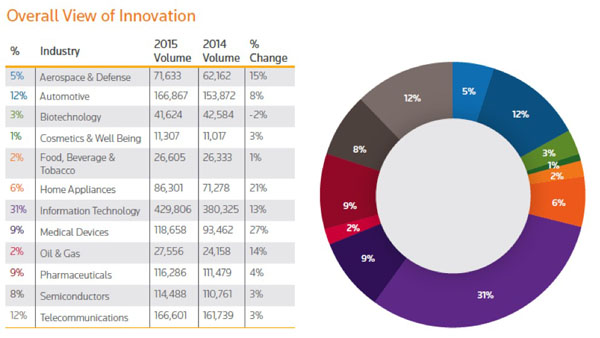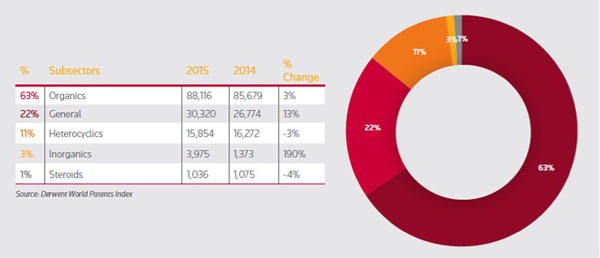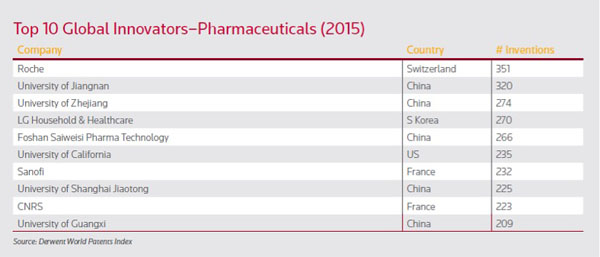The pharmaceutical world is littered with innovation pitfalls. With longer product cycles, several layers of regulatory approval and various global hurdles to overcome, patent volumes in the pharmaceutical industry are often dwarfed by those of fast-moving industries.
And even when drug patents are issued, a vast array face litigation, as rivals look to gain a competitive advantage over one another. But that doesn’t mean life sciences companies aren’t making some serious strides toward changing the future of this space.
In the latest edition of its annual The Future is Open: State of Innovation Report 2016, Clarivate Analytics researchers tracked global intellectual property data, including scientific literature and patents, as a window into innovation across 12 bellwether technology areas: aerospace; automotive; nanotechnology; computing and peripherals; cosmetics; domestic appliances; food, tobacco and beverage fermentation; medical devices; petroleum; pharmaceuticals; semiconductors and telecommunications.
For each industry, analysts scrutinised 5 years of global patent and scientific literature publications, outlining the top companies, research institutions and technology areas producing the highest volume of new innovation. According to the research, the pharmaceutical industry is thriving, fuelled by a specific sector.
The category experienced 4% year-on-year growth, with the most significant increase coming in a burgeoning inorganics sector.
This growth in 2015 was a symptom of an evolving landscape in the industry. The current pharmaceutical success trend is a result of a concoction featuring an increased focus on rare diseases, ongoing development of more convenient fixed dose combination (FDC) regimens and the continuation of the conflict between price and access to medicines.
These, alongside new treatments involving bio-organisms, several new vaccines (including malaria and dengue fever) and immune-therapies, have given the sector a burst of adrenaline.
Pharma patents still rising
It’s not easy getting a pharmaceutical patent filed, and it’s clear to see when we glimpse at the overall volume of patents broken down by industry in Figure 1.

Figure 1: Overall view of innovation
As opposed to categories such as information technology and telecommunications that have a relatively low threshold to entry, pharmaceutical patents take a much longer time to develop. Once the R&D is done, the regulatory steps begin.
As a result, the 116,286 total patents filed pale in comparison to IT, but the 4% year-on-year growth still reflects a thriving innovation environment.
Inorganics lead pharma industry growth
The most indicative of these trends is the rapid-fire growth of inorganics, which include all non-carbon-based chemical compounds, featuring an array of metallic compounds as well as those that are synthesised in a chemical plant or lab. The sector jumped up by 190%, from 1373 to 3975 unique inventions for the period (Figure 2).

Figure 2: Growth in pharmaceutical chemical compounds (2014–2015)
Although inorganics still make up a relatively small slice of the pharmaceutical pie, there’s certainly reason to be bullish about them moving forward. With fewer than 4000 patents in 2015, there’s plenty of room for new R&D to play a role in further expansion, meaning when we revisit the topic 1 year in the future, the make-up of many pharmaceutical companies’ patent portfolio could be far more diverse.
China paces the world’s growing drug market
The People’s Republic of China has long been making itself a dominant player in the patent game, and the pharmaceutical space is no different.
Globally, China is the world’s leading region for pharmaceutical innovation, with 50% of the top 10 pharmaceutical companies residing there: University of Jiangnan, University of Zhejiang, Foshan Saiweisi Pharma Technology, University of Shanghai Jiaotong and University of Guangxi.
The reason? Their willingness to work within an open access approach. Public and private sectors seem to be working hand in hand, as all of China’s representatives are from academia (Figure 3).

Figure 3: Top 10 global pharmaceutical innovators (2015)
The part collaboration plays in innovation is a prerequisite for future pharmaceutical growth to meet the health and drug needs of a larger population, especially in developing nations, and to ensure the longevity of an ageing demographic.
Research and development models will increasingly shift to involve partnerships between pharma companies and either their suppliers or partners, allowing each party to focus on its respective area of expertise. The testing of ‘virtual beings’ is also expected to expedite development and trial cycles, bringing drugs to market much quicker.
The Rx factor
The pharmaceutical industry presents its unique set of challenges when it comes to patents. But in an ever-evolving world of healthcare needs, drug makers continue to meet the varied needs of the market. The industry continues to grow, thanks to its ability to branch into creative and new markets.
Clarivate Analytics predicts that seven drugs expected to launch this year will achieve blockbuster sales status of more than $1 billion in revenue by 2020, with some predicted to hit $2 billion during that period. It is clear that pharmaceutical innovation is alive and well.




